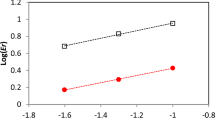Abstract
This study describes the application of two main improvements in highly viscous fluid simulations using the smoothed particle hydrodynamics (SPH) method: an implicit time integration scheme to overcome the problem of impractically small time step restriction and the introduction of air ghost particles to fix problems regarding the free surface treatment. This study adopts the incompressible SPH as a basis for the implementation of these improvements, which guarantees a stable and accurate pressure distribution. We verified the proposed implicit time integration scheme with simulations of pipe flow and the free surface treatment with a simple hydrostatic problem. As a result, the free surface of the hydrostatic problem became very smooth and stable. In addition, we conducted a variety of dam-break simulations to validate this proposed SPH method, as well as to analyze the density and divergence error. Finally, we demonstrate the potential of this method with the highly viscous vertical jet flow over a horizontal plate test, which features a complex viscous coiling behavior.































Similar content being viewed by others
Abbreviations
- SPH:
-
Smoothed particle hydrodynamics
- ISPH:
-
Incompressible smoothed particle hydrodynamics
- MPS:
-
Moving particle semi-implicit
- AGP:
-
Air ghost particles
References
Lucy LB (1977) A numerical approach to the testing of the fusion process. Astron J 88:1013–1024
Gingold RA, Monaghan JJ (1977) Smoothed particle hydrodynamics: theory and application to non-spherical stars. Mon Not R Astron Soc 181:375–389
Asai M, Aly AM, Sonoda Y, Sakai Y (2012) A stabilized incompressible SPH method by relaxing the density invariance condition. Int J Appl Math 2012:139583. https://doi.org/10.1155/2012/139583
Colagrossi A, Landrini M (2003) Numerical simulation of interfacial flows by smoothed particles hydrodynamics. J Comput Phys 191(2):448475
Ihmsen M, Cornelis J, Solenthaler B, Horvath C, Teschner M (2014) Implicit incompressible SPH. IEEE Trans Vis Comput Graph 20(3):426–435
Violeau D, Rogers BD (2016) Smoothed particle hydrodynamics (SPH) for free surface flows: past, present and future. J Hydraul Res 54(1):1–26
Morris JP, Fox PJ, Zhu Y (1997) Modeling low Reynolds number incompressible flows using SPH. J Comput Phys 136:214–226
Marrone S, Antuono M, Colagrossi A, Le Touze D, Graziani G (2011) δ-SPH model for simulating violent impact flows. Comput Methods Appl Mech Eng 200:1526–1542
Asai M, Fujimoto K, Tanabe S, Beppu M (2013) Slip and non-slip boundary treatment using virtual markers in the analysis of incompatible step-shape boundary using particle method. Trans JSCES. Article ID 139583
Idris NA, Sonoda Y (2017) A multi-level tsunami run-up simulation based on 3D particle method with a virtual wave maker (Doctoral Dissertation, Kyushu University, Fukuoka, Japan). Retrieved from Kyushu University Institutional Repository (Record ID 1807037). https://doi.org/10.15017/1807037
Schechter H, Bridson R (2012) Ghost SPH for animating water. In: Proceedings of SIGGRAPH 2012 conference, vol 31(4), Article No. 61
Tsuruta N, Khayyer A, Gotoh H (2015) Space potential particles to enhance the stability of projection-based particle methods. Int J Comput Fluid Dyn. https://doi.org/10.1080/10618562.2015.1006130
Schoenberg IJ (1946) Contributions to the problem of approximation of equidistant data by analytic functions. Q Appl Math 4:45–99
Violeau D, Leroy A (2014) On the maximum time step in weakly compressible SPH. J Comput Phys 256:388–415
Papanastasiou TC (1987) Flows of materials with yield. J Rheol 31(5):385–404
de Larrard F, Ferraris CF, Sedran T (1998) Fresh concrete: a Herschel–Bulkley material. Materials and Structures/Matériaux et Constructions. 31:494–498
Cotela-Dalmau J, Rossi R, Larese A (2017) Simulation of two- and three-dimensional viscoplastic flows using adaptive mesh refinement. Int J Numer Methods Eng 112:1636–1658. https://doi.org/10.1002/nme.5574
Violeau D, Issa R (2017) Numerical modelling of complex turbulent free-surface lows with the SPH method: an overview. Int J Numer Methods Fluids 53(2):277–304. https://doi.org/10.1002/fld.1292
Marrone S, Colagrossi A, Le Touzé D, Graziani G (2010) Fast free-surface detection and level-set function definition in SPH solvers. J Comput Phys 229:3652–3663
Munson BR, Young DF, Theodore HO (2005) Fundamentals of fluid mechanics, 5th edn. Wiley, New York
Mattiusi EM (2007) Escoamento laminar de fluidos Newtonianos generalizados em tubos de seção transversal elíptica [Laminar flow of generalized Newtonian fluids in elliptical cross-section pipes] (Unpublished Master thesis, Federal Technological University of Paraná, Paraná, Brazil)
Martin JC, Moyce WJ (1952) An experimental study of the collapse of liquid columns on a rigid horizontal plane. Philos Trans R Soc Lond 244(882):312–324
Minussi RB, Maciel GF (2012) Numerical experimental comparison of dam break flows with non-Newtonian fluids. J Braz Soc Mech Sci Eng XXXIV(2):167
Tomé MF et al (2004) A numerical method for solving three-dimensional generalized Newtonian free surface flows. J Non-Newtonian Fluid Mech 123:85–103
Takahashi T, Dobashi Y, Fujishiro I, Nishita T, Lin MC (2015) Implicit formulation for SPH-based viscous luids. Comput Gr Forum 34(2):493–502
Ribe NM, Habibi M, Bonn D (2012) Liquid rope coiling. Annu Rev Fluid Mech 44:249–266. https://doi.org/10.1145/annurev-fluid-120710-101244
Acknowledgements
We thank Richard Haase, PhD, from Edanz Group (www.edanzediting.com/ac) for editing a draft of this manuscript.
Funding
The first author is supported by Japan International Cooperation Agency (JICA) under the program Scholarship for Japanese Emigrants and their Descendants in Latin America and the Caribbean: Program for Developing Leaders in Nikkei Communities. This work was supported by Japan Society for the Promotion of Science (JSPS) KAKENHI Grant Number JP17H02061 and “Joint Usage/Research Center for Interdisciplinary Large-scale Information Infrastructures” in Japan (Project ID: jh180060-NAH and jh180065-NAH).
Author information
Authors and Affiliations
Corresponding author
Ethics declarations
Conflict of interest
The authors declare that they have no conflict of interest.
Additional information
Publisher's Note
Springer Nature remains neutral with regard to jurisdictional claims in published maps and institutional affiliations.
Rights and permissions
About this article
Cite this article
Morikawa, D., Asai, M., Idris, N. et al. Improvements in highly viscous fluid simulation using a fully implicit SPH method. Comp. Part. Mech. 6, 529–544 (2019). https://doi.org/10.1007/s40571-019-00231-6
Received:
Revised:
Accepted:
Published:
Issue Date:
DOI: https://doi.org/10.1007/s40571-019-00231-6



